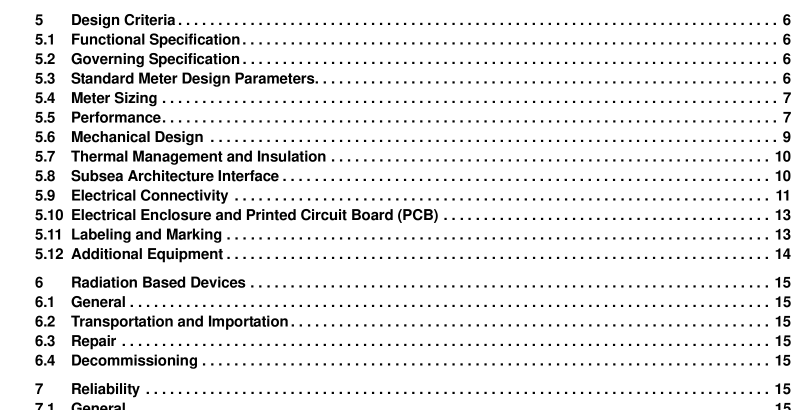API RP 17S:2015 pdf free download.Recommended Practice for the Design, Testing, and Operation of Subsea Multiphase Flow Meters
Allocation and fiscal measurements are used in conjunction with procedures for volume or financial calculation for ownership and thus require the lowest level of measurement uncertainty and repeatability, along with increased instrument calibration.
To ensure an MPFM meets these strict requirements, flow tests across the range of operating conditions are recommended (see 8.5). The terms of any meter testing and fluid sampling required are often part of the associated operational contract. Well management/flow assurance applications are defined by the need to track changes in fluid composition. Fluid phase changes are of particular concern in gas lift, water breakthrough, and some chemical injection applications. Tracking the difference between measurements over a period of time, rather than any individual measurement, is of greatest concern
. Therefore the requirement for rigorous sampling, in situ calibration, and independent flow tests can be reduced. For all potential applications, the uncertainty required from the meter should be determined from an appropriate study conducted on the flow assurance model of the system. The study should conclude with definitions of acceptable uncertainty across the volume fractions for specific flow conditions or well trajectories. From this study, the responsible engineer should define the specific requirements for uncertainty, repeatability, and reproducibility for the meter application. Validating stringent performance characteristics has an economic impact that needs to be justified by the criticality of the meter application.
4.2 MPFM Locations The location of the MPFM is somewhat dependent on its intended application and the overall field layout. Location options include tree mounted units typically as part of a choke bridge/flow module/retrievable module, jumper mounted units, and placement in a manifold. Generally, the meter application and equipment size influences or determines the best location. Dedicated MPFMs for individual wells can be located on the tree, connected jumper, or on an adjacent manifold for continuous measurement. Intermittent flow measurement can be accomplished at a manifold which accommodates direction of individual well streams through a single meter.
The single meter can contain relevant PVT data for multiple wells. The specific well data can be utilized when a particular well is directed through the meter.
This layout may not be suitable for continuous individual well tracking. Individual meter costs and reliability may influence the decision of single versus multiple locations. Multiple meters may require additional operational management depending on application. Access for installing and retrieving MPFMs and meter electronic modules should be considered in any field layout (see 7.3). Mechanical interfaces are detailed in 5.8.
Intervention of tree and jumper mounted units may only affects production at that specific location. Retrieval of units from manifolds may require shut-in of multiple wells if a bypass is not available or working over adjacent structures is prohibited. This can be due to a situation in which double isolation and integrity assurance is not available.
Manifold designs with bypass lines should ensure maximum production is maintained during meter shutdown or retrieval. Recommendations for the flow geometry upstream and downstream are dependent on measurement technology, and are normally given by the supplier of the meter and should be considered as part of meter location. In addition, erosion concerns should be addressed in all applications, e.g. high velocity wet gas with potential for spiral flow. Consideration for meter location can also be affected by chemical injection point, piping configuration, and proximity to a flow restriction since this relates to meter performance (see 5.3 for further design parameters).
5 Design Criteria
5.1 Functional Specification Since MPFMs use various measurement technologies to ascertain different parameters regarding the flow stream, there is no one standard technology. Users should become familiar with the various principles and measurement technologies as detailed in API MPMS Ch. 20.3. A functional specification for the meter should be provided by the manufacturer. This specification should detail the methodology used for determining the components of the multiphase flow undergoing measurement. The specific technologies used should be explained, and both their input requirements and resultant measurement should be defined. In addition, an outline of how the constituent flow rates are determined from meter in situ physical measurements, flow models, and configuration input parameters should be provided.API RP 17S pdf download.API RP 17S:2015 pdf free download
